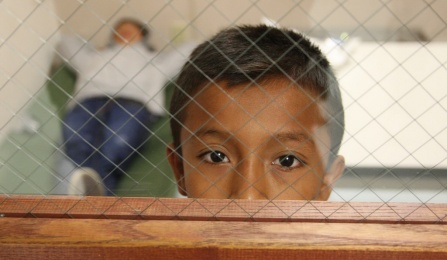Law Links - November 2014
Hard choices on the nation’s southern border

A boy looks out the door window from the room he is staying in at the Brownsville, Texas, port of entry. Photo by Edwardo Perez, courtesy of U.S. Customs and Border Protection.
The flood of unaccompanied minors showing up at the U.S.-Mexico border – driven from their homelands by pervasive violence and gang activity – was the focus of a student-sponsored panel discussion that brought some legal light to a heated issue.
Tens of thousands of children, some as young as 6, have been arriving at the border without parents or other responsible adults. At the forum, held Oct. 29 in the fifth-floor Cellino & Barnes Conference Center, three SUNY Buffalo Law professors and an attorney who works with refugees took up the question of how we should treat unaccompanied minors at the border.
The forum, sponsored by the Latin American Law Students Association, featured Professor Rick Su and Associate Professor Anjana Malhotra, both specialists in immigration law, and Emma Buckthal, an immigration staff attorney with the Volunteer Lawyers Project in Buffalo. The discussion was moderated by Professor Luis E. Chiesa, vice dean for academic affairs and director of the Buffalo Criminal Law Center.
Following a brief overview of the situation at the nation’s southern border, the panelists took up the question of why this influx is happening.
“There’s incredible violence in some of these countries, especially El Salvador,” Su noted. “El Salvador has the highest murder rate in the world.”
Buckthal said much of the influx comes from El Salvador, Honduras and Guatemala, and noted that children from different countries are treated differently. Mexican children, she said, are typically handed off to Mexico’s Department of Infants and Families, but the United States lacks the same agreement with other countries of origin.

Associate Professor Anjana Malhotra
Malhotra, who noted that only an estimated one in three of the child refugees has a parent in the United States, said one issue in the immigration system is that those caught up in it have no right to government-supplied counsel, as criminal defendants do. To address that need, she said, lawyers are being encouraged to form networks to represent asylum applicants pro bono.
Su noted that most of these children are “essentially turning themselves in” rather than trying to sneak past Border Patrol agents. “The American crisis is an administrative crisis,” he said. “We have had a system in place, but it’s been swamped.”

Professor Rick Su
Su said applying for asylum on the basis of gang activity in the children’s home country is problematic. “Our asylum law does not recognize gang activity at this time,” he said. “Asylum law has never been very good about failed states.”
“This is a refugee crisis,” Malhotra said. “These parents are putting their kids’ lives in danger by sending them here because the violence rates are so high. I think [the United Nations High Commissioner for Refugees] should be there, because it works to address crises where the state is absent.
“We have an obligation here. The journey these kids are taking is fraught with violence and other risks. Hundreds of people die here in the desert. These folks are just like us; they’re making these hard choices, whether they’re here or there.”
The panelists said the larger issue of the reform of immigration laws is being buried under publicity around the young border-crossers. “The imagery is the problem,” Su said. “It makes it seem that the border is not under control, even though the vast majority of evidence shows almost 100 percent are being apprehended. It has become a battle of ‘Is the border secure?’ and we can’t talk about anything else until that gets settled.”